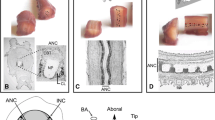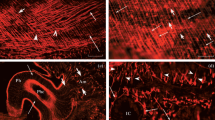Summary
Evidence is presented for acetylcholine as neurotransmitter in the sensory epithelia (macula and crista) of the statocyst of Octopus vulgaris, based on the following techniques: (i) histochemical assay of acetylcholinesterase at light- and electron-microscopical levels, in combination with the detailed knowledge of the ultrastructural and neuronal organization of the receptor epithelia; (ii) lesion/degeneration experiments of the efferent fibre system; (iii) radiochemical assay of acetylcholine; and (iv) bioassay of acetylcholine. All data support the hypothesis that in the statocyst of O. vulgaris acetylcholine acts as a neurotransmitter in the efferent fibre system.
Similar content being viewed by others
References
Barber VC (1966) The fine structure of the statocyst of Octopus vulgaris. Z Zellforsch 70:91–107
Barber VC, Graziadei P (1966) Cephalopod synaptic organization. 6th Int Congr Electron Microsc 2:433–434
Barlow JJ (1971) The distribution of acetylcholinesterase and catecholamines in the vertical lobe of Octopus vulgaris. Brain Res 35:304–307
Barlow JJ (1977) Comparative biochemistry of the central nervous system. Symp Zool Soc Lond 38:325–346
Budelmann BU (1977) Structure and function of the angular acceleration receptor systems in the statocysts of cephalopods. Symp Zool Soc Lond 38:309–324
Budelmann BU, Bonn U (1982) Histochemical evidence for catecholamines as neurotransmitters in the statocyst of Octopus vulgaris. Cell Tissue Res 227:475–483
Budelmann BU, Thies G (1977) Secondary sensory cells in the gravity receptor system of the statocyst of Octopus vulgaris. Cell Tissue Res 182:93–98
Budelmann BU, Wolff HG (1976) Mapping of neurons in the gravity receptor system of the Octopus statocyst by iontophoretic cobalt staining. Cell Tissue Res 171:403–406
Budelmann BU, Young JZ (1984) The statocyst-oculomotor system of Octopus vulgaris: extraocular eye muscles, eye musclenerves, statocyst nerves and the oculomotor centre in the central nervous system. Phil Trans R Soc Lond B 306:159–189
Budelmann BU, Sachse M, Staudigl M (1986) The angular acceleration receptor system of the statocyst of Octopus vulgaris: morphometry, ultrastructure, and neuronal and synaptic organization. Phil Trans R Soc Lond B (submitted)
Chichery MP, Chichery R (1974) Histochemical study of the localization of cholinesterases in the central nervous system of Sepia officinalis. Cell Tissue Res 148:551–560
Colmers WF (1977) Neuronal and synaptic organization in the gravity receptor system of the statocyst of Octopus vulgaris. Cell Tissue Res 185:491–503
Colmers WF (1981) Afferent synaptic connections between hair cells and somata of intramacular neurons in the gravity receptor system of the statocyst of Octopus vulgaris. J Comp Neurol 197:385–394
Colmers WF (1982) The central afferent and efferent organization of the gravity receptor system of the statocyst of Octopus vulgaris. Neuoscience 7:461–476
Dowdall MJ, Simon EJ (1973) Comparative studies on synaptosomes: uptake of (N-Me-3H)choline by synaptosomes from squid optic lobes. J Neurochem 21:969–982
Dowdall MJ, Whittaker VP (1973) Comparative studies in synaptosome formation: the preparation of synaptosomes from the head ganglion of the squid, Loligo pealii. J Neurochem 20:921–935
Ducros C (1979) Synapses of cephalopods. Int Rev Cytol 56:1–22
Eränkö O, Räisänen L (1965) Fibres containing both noradrenaline and acetylcholinesterase in the nerve net of the rat iris. Acta Physiol Scand 63:505–506
Florey E, Winesdorfer J (1968) Cholinergic nerve endings in Octopus brain. J Neurochem 15:169–177
Fraser Rowell CH (1963) A general method for silvering invertebrate central nervous systems. Quart J Micr Sci 104:81–87
Gomori G (1952) Microscopic histochemistry: principles and practice. University of Chicago Press, Chicago
Henderson JR (1967) The use of silver for intensifying sulfide deposits in the cholinesterase technique. Stain Technol 42:101–102
Jones DG (1967) An electron-microscope study of subcellular fractions of Octopus brain. J Cell Sci 2:573–586
Juorio AV (1971) Catecholamines and 5-hydroxytryptamine in nervous tissue of cephalopods. J Physiol 216:213–226
Lewis PR, Shute CCD (1966) The distribution of cholinesterase in cholinergic neurons demonstrated with the electron microscope. J Cell Sci 1:381–390
Loe PR, Florey E (1966) The distribution of acetylcholine and cholinesterase in the nervous system and in innervated organs of Octopus dofleini. Comp Biochem Physiol 17:509–522
Martin R, Frösch D, Kiehling C, Voigt KH (1981) Molluscan neuropeptide-like and enkephalin-like material coexists in Octopus nerves. Neuropeptides 2:141–150
McCaman RE, Stetzier J (1977) Radiochemical assay for ACh: modifications for sub-picomole measurements. J Neurochem 28:669–671
Suzuki H, Tasaki K (1983) Inhibitory retinal efferents from dopaminergic cells in the optic lobe of the Octopus. Vision Res 23:451–457
Tansey EM (1979) Neurotransmitters in the cephalopod brain. Comp Biochem Physiol 64C: 173–182
Tansey EM (1980) Aminergic fluorescence in the cephalopod brain. Phil Trans R Soc Lond B 291:127–145
Tyrer NM, Bell EM (1974) The intensification of cobalt-filled neurone profiles using a modification of Timm's sulphide-silver method. Brain Res 73:151–155
Villegas GM, Villegas J (1974) Acetylcholinesterase localization in the giant nerve fiber of the squid. J Ultrastruc Res 46:149–163
Vinnikov YA, Gasenko OG, Bronstein AA, Tsirulis TP, Ivanov VP, Pyatkina GA (1967) Structural, cytochemical and functional organization of statocysts of Cephalopoda. Symposium on neurobiology of invertebrates. Akadémiai Kiadó, pp 29–48
Welsch F, Dettbarn WD (1972) The subcellular distribution of acetylcholine, cholinesterases and choline acetyltransferase in optic lobes of the squid itLoligo pealei. Brain Res 39:467–482
Whittaker VP, Barker LA (1972) The subcellular fractionation of brain tissue with special reference to the preparation of synaptosomes and their component organelles. Methods Neurochem 2:1–52
Young JZ (1960) The statocyst of Octopus vulgaris. Proc R Soc Lond B 152:3–29
Young JZ (1971) The anatomy of the nervous system of Octopus vulgaris. Clarendon Press, Oxford
Author information
Authors and Affiliations
Additional information
This paper is dedicated to Professor Franz Huber, Seewiesen, on the occasion of his 60th birthday
Rights and permissions
About this article
Cite this article
Auerbach, B., Budelmann, BU. Evidence for acetylcholine as a neurotransmitter in the statocyst of Octopus vulgaris . Cell Tissue Res. 243, 429–436 (1986). https://doi.org/10.1007/BF00251060
Accepted:
Issue Date:
DOI: https://doi.org/10.1007/BF00251060




